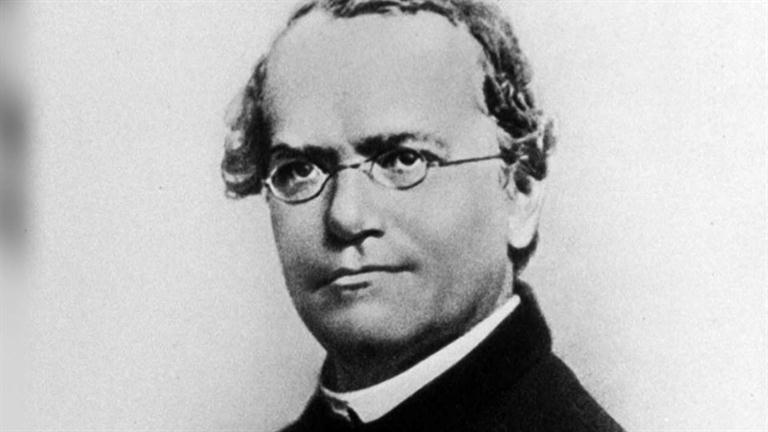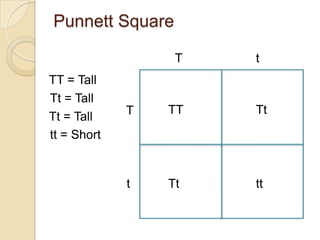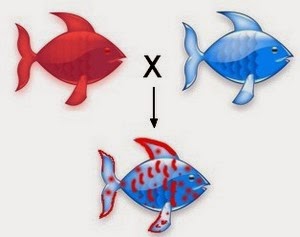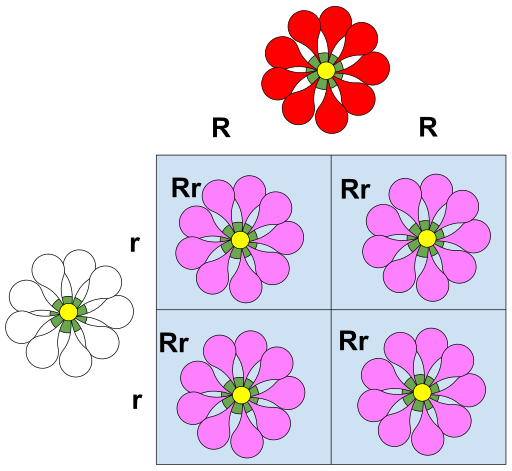Mendellian genetics
This branch of biology is about heredity and has some interesting vocabulary (bold faced in the writing). You may benefit from making flashcards for these new terms because you will not get the benefit of hearing them daily in class. This field of science was refined and defined by this man:

This is Gregor Mendel, a Czech monk doing his research in the mid 1800s.
Having lots of time and curiosity, he began breeding pea plants in the monastery garden and noticed something interesting.
He crossed tall plants with short plants and got all tall offspring.
When he crossed those offspring, 25% of them were short! This confused him for a while until he hypothesized that each of us has a phenotype (physical trait we show) and a genotype (what our genes are) and sometimes more than one genotype can show the same phenotype. To make his model work, each parent had to contribute an equal amount of DNA (something liberating to say that the parents were equal in their contribution to the offspring). This means that all of us have two copies of each gene--one from mom and one from dad. These copies are called alleles.
In his first crossing, all the plants were purebred. That means that both the copies (alleles) were the same. This he termed Homozygous, a term meaning that both copies are the same (homo means "same"). One plant was homozygous tall and the other was homozygous short. Every pollen or ovary from the tall plant was a tall allele. Every pollen or ovary from the short plant was a short allele. That means that every offspring had one tall allele and one short allele. They were a hybrid; a mix. He termed them Heterozygous, a term meaning that the alleles are different from each other (one tall and one short).
Interestingly, in his first cross, all the hybrids were tall. That meant that tall dominated short in the pea plant and so the tall trait was named Dominant and the short trait was named Recessive.
He made a mathematical model of this:

He used "T" to represent the dominant tall allele and "t" to represent the recessive short allele.
The phenotype in the first cross was 100% tall and the genotype was 100% Tt
The phenotypes in the second cross was 75% tall and 25% short and the genotype was 25% TT, 50% Tt, and 25% tt
He then played around with other traits and found many of them followed the same pattern. Wrinkled peas, yellow peas, etc. all were dominant or recessive. Humans have several traits like this. Tongue rolling, attached earlobes, widows peak, etc. I have a dominant / recessive exploration of yourself for you to complete. It can be found linked here.
However, some of the traits he explored showed other patterns. Sometimes the two traits both showed up in the offspring. He called that Codominant. An example would be crossing a red flower with a blue flower and getting a red and blue flower.

Some traits blended where neither trait completely dominated the other. He called that Incomplete Dominance. An example would be crossing a red flower with a blue flower and getting a purple flower.

Now that you know dominance, recessive, codominance, and incomplete dominance, you can make a baby! Not a real baby, but this hypotheical offspring.
One last thing he noticed. Some traits seemed linked to the sex of the organism. He called these Sex-linked. Since the Y chromosome in males is missing the bottom leg that the X chromosome has, males only have one copy of any gene found on that section of the chromosome. They got that allele from mom. Females have two copies. This means that some traits show up much more often in males since they do not have a second copy to cover for any defect.
When you think you have the hang of these punnett squares find a worksheet here to see if you can do them all.
For help understanding punnett squares, here is a video I made years ago to help kids. I hope it helps you, too.
The last part of this unit is an overview of pedigrees. A pedigree is a map of a family tree showing relationships and tracing a trait.
Here are the agreed upon ways to mark a person:

Here would be an example tracing a recessive trait:

From this chart, you can trace so much. For example, to show the recessive trait, you have to have two copies. So all the shaded people, must be "dd". All the not affected people must have at least one "D." But you can tell their hidden allele most of the time. For example, person 1 must have the recessive allele hiding because he had two sones with the trait. If they were born with "dd," they must have gotten one of those "d"s from him. Similarly, both persons 1 and 2 in the second generation did not show the disease, but were able to pass along a little "d" to one of their sons, so they must also be "Dd." The only ones we cannot tell is persons 1 and 2 in the 3rd generation because we do not know if either has a hiding "d" or not.
I have a worksheet for you to try to crack the mystery of everyone's genotype. Please find it here.
Here is a video I made years ago to help kids understand pedigrees. I hope it helps.
Lastly, it would be awesome if you picked a trait and made up your own pedigree. Because this requires genetic relationships, you may choose to do a trait in someone else rather than yourself. One year a student found that autism in their family followed a sex-linked pattern. You can trace hemophilia in the royal family. Have fun with this.
Are you ready for the Mendeliian genetics test? How are you with the vocab? Genotype, phenotype, allele, heterozygous, homozygous, dominance, recessive, codominance, incomplete dominance, sex-linked, pedigree? Can you fill in a punnett square with crosses? Can you do some detective work on a pedigree? If so, you are ready for this test.